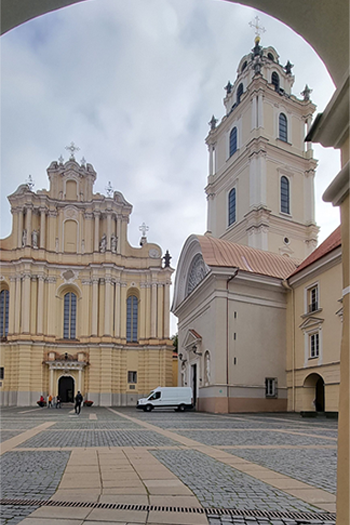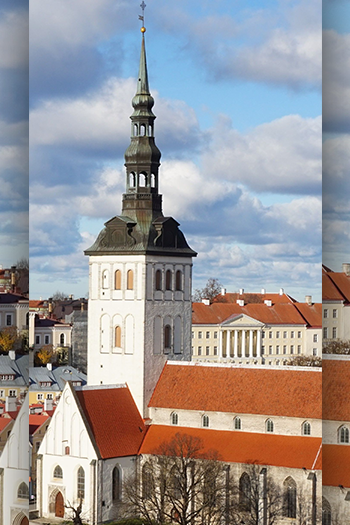HISTORY OF PRESERVATION AND MAINTANANCE

VILNIUS Cultural heritage preservation is a comparatevely new phenomenon which appeared at the 19th century in Europe. First enlightened persons became interested in cultural heritage in Lithuania also at 19th c. Vilnius Archaeological Commission was active during 1856 – 1864. First restoration of cultural heritage buildings (Vilnius University, the Upper Gediminas Castle, St. Anne‘s Church), was done at the beginning of 20th c. in Vilnius by Polish restorers. World War II brought a significant damage to the Old Town –the Great Synagogue and the Jewish quarter, part of the Vokiečiu Street (Deutsche gasse) and several other quarters were destroyed. Squares or modern buildings replaced elements demolished at the postwar period. Vilnius Old Town first time was declared as a special protected zone in 1958. Three regeneration plans of the Old Town were prepared during 1956 – 1992. Street network, the building character, cutural heritage buildings and their ensembles were protected according to these plans. Complex regenaration of separate Old Town quarters was implemented. These works were quite significant for the preservation of the Old Town. It has always been a source of national pride that we have found ways to conserve our heritage, even through periods of occupation. The last Regenaration plan of 1988-1992 presented the romantic patriotic vision of the reconstruction of the mediaval town. The main realisation of this concept was the reconstruction of the Lower Castle – Palace of the Grand Dukes of Lithuania (2002 – 2009).
Vilnius Old Town Revitalisation Strategy was prepared by the group of international experts with
the support of the World Bank in 1996. The Strategy provided for the need of setting up an Old
Town Renewal Agency, which had to be established both by the Ministry of Culture and by Vilnius
City Municipality. In 1998 the Agency was established by the Municipality only. The Agency
continuously implements the principles and provisions of the World Heritage Convention ; the
activities of the Agency are financed only by Vilnius City Municipality.
The Minister of Culture of the Republic of Lithuania and the the Department of Cultural Heritage
are responsible for safeguarding the Old Town. The other responsible partners are Vilnius City
Municipality, the Division of Cultural Heritage and Vilnius Old Town Renewal Agency. The
attributes of the property are protected by the Vilnius Strategic Plan (2010), the Vilnius Official
Plan (2021), the Regulation on the Protection of the Old Town (2003) and the actions taken by the
annual Old Town Revitalisation Programme.
Criteria for designation
Vilnius Historic Centre (Old Town) has been a UNESCO World Heritage Site since 1994.
Criteria for designation of Vilnius to the UNESCO World Heritage List
HISTORY OF PRESERVATION AND MAINTANANCE

TALLINN – early historic mentions, dominant objects, and events
– Initial actions and results of architectural and urban preservation
– Inspirations, actors, and main arguments developing a nomination
Tallinn was first mentioned in the Livonian Chronicle of Henry (Heinrici Chronicon Lyvoniae) where he describes how the Danish fleet led by King Valdemar II landed near Lindanise hillfort and commenced into a difficult but victorious battle on June 15th, 1219.
After the battle, the Danes started building a stone castle and the archbishop of Lund, Andreas Sunesen became the first regent of Denmark in Tallinn.
Tallinn Old Town is a complete and well-preserved medieval North-European trading town on the coast of the Baltic Sea. The town evolved during the heyday of the Hanseatic League in the 13th-16th centuries and was an important center within that vast trading organization.
The Old Town includes the upper town on the high limestone plateau and the lower town at its base with the numerous church spires that form an impressive silhouette visible from land as well as sea. The dominant objects in the upper town are the Toompea Castle, the Cathedral of the Virgin Mary and the Aleksander Nevski Cathedral. The lower town is also dominated by the churches: St. Olaf‘s, St. Nicholas‘, The Holy Ghost‘, Transfiguration of the Lord‘s and St. Nicholas the Wonderworker‘s, and also the Old Town Hall.
The restoration history of Tallinn can be taken back to the year 1625, when St. Olaf‘s Church was restored after a fire. It is also worth to mention the restoration of the spires of the Holy Ghost Church in 1685 and the Town Hall in 1781. St. Olaf‘s Church was thorougly restored in 1828-¬1840 after the fire caused by lightning on 16 June 1820. , when St. Olaf‘s Church was restored after a fire. It is also worth to mention the restoration of the spires of the Holy Ghost Church in 1685 and the Town Hall in 1781. St. Olaf‘s Church was thorougly restored in 1828-1840 after the fire caused by lightning on 16 June 1820.
Historic value
Conscious preservation based on the the historic value of the Old Town goes back to the beginning of the 20th century, when restoration was started on segments of the Town Wall and on the defence towers. As a predecessor of the current Heritage Conservation Advisory Panel the Heritage Council was established with the 1925 Heritage Conservation Act. The 1936 Heritage Protection Law provided protection for 41 objects of Tallinn Old Town, inter alia 12 city fortification structures, and included them in the list of historic property. World War II brought serious damage to the Old Town – in the air raid of March 9, 1944 several quarters around St. Nicholas Church were destroyed, smaller damage occurred in other parts of the Old Town. In 1947 the first heritage conservation area in Toompea was constituted; in addition, 87 historic properties including city fortifications (the Town Wall, towers, gate constructions, bastions and the moat) were taken under heritage protection. Several ruins were placed under protection with the prospect of rebuilding them. The end of the 1950s marks the beginning of a conscious and successful conservation of Tallinn Old Town as a whole.
Already the first Statutes of Tallinn Heritage Conservation Area adopted in 1966 prohibited, as a general rule, the construction of new buildings and extensions to existing buildings in Old Town. Such activities were allowed only by a separate permit issued by the so-called Executive Committee and based on special restrictions. The 1995 Statutes adopted in the Republic of Estonia specified those provisions: new buildings are allowed to be constructed only on the sites of buildings destroyed in World War II, and extensions to existing buildings have to be harmonised with the historically developed architectural structure, street network, diversity of styles and ages, volumes of buildings, perspective views, silhouette, roofline, and other factors characteristic of the Old Town.
Tallinn Old Town was inscribed on the World Heritage List in 1997. Tallinn Old Town derives its Outstanding Universal Value mainly from its rich layers of archaeological findings, well-preserved historical buildings and street network, mostly preserved fortifications, and traditional use as a living environment.
The Outstanding Universal Value of Tallinn Old Town is articulated in five major characteristics:
1) a rich layer of archaeological findings from the 800 years of town history as well as from the preceding 5,000 years of human settlement;
2) well-preserved many-layered dwellings, public and sacred buildings with a strong medieval component;
3) a medieval street network that has preserved its original structure;
4) a mostly preserved circular town wall and earthworks turned into green areas;
5) a traditional living environment.
